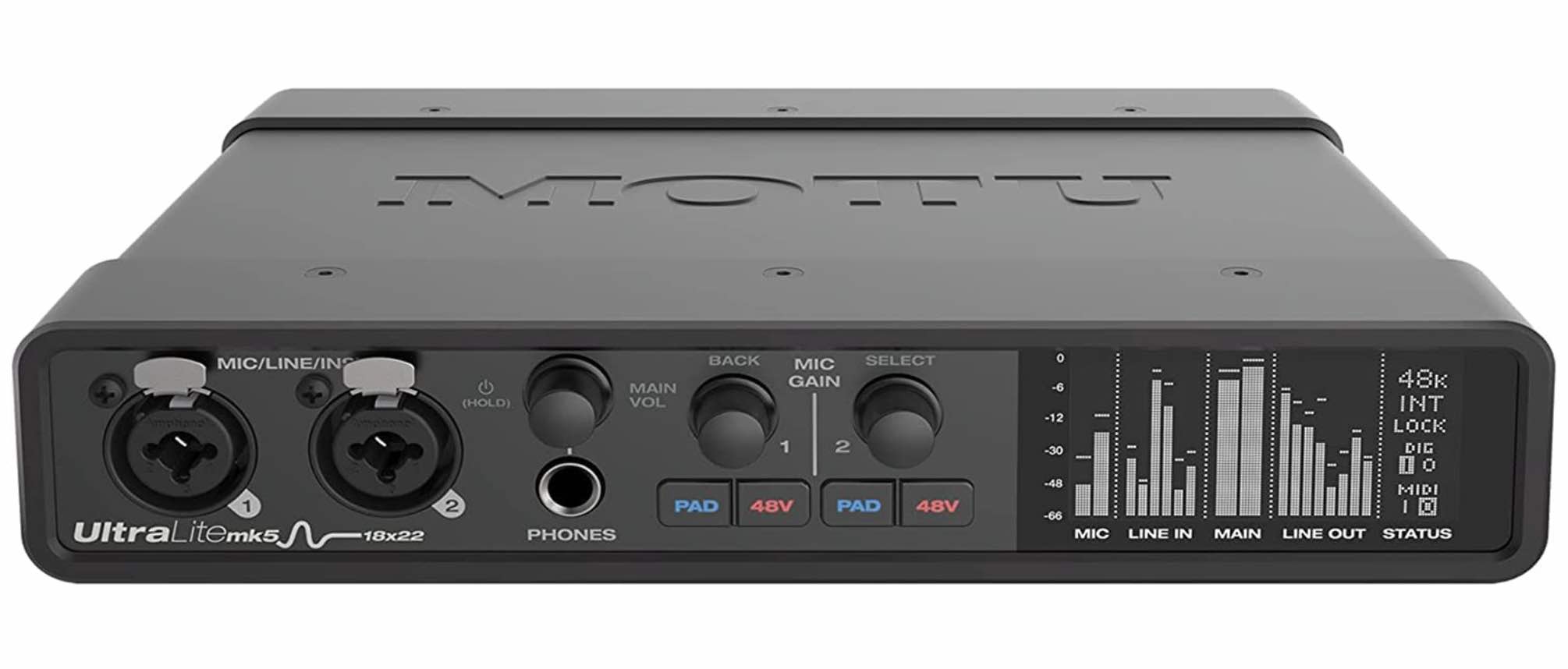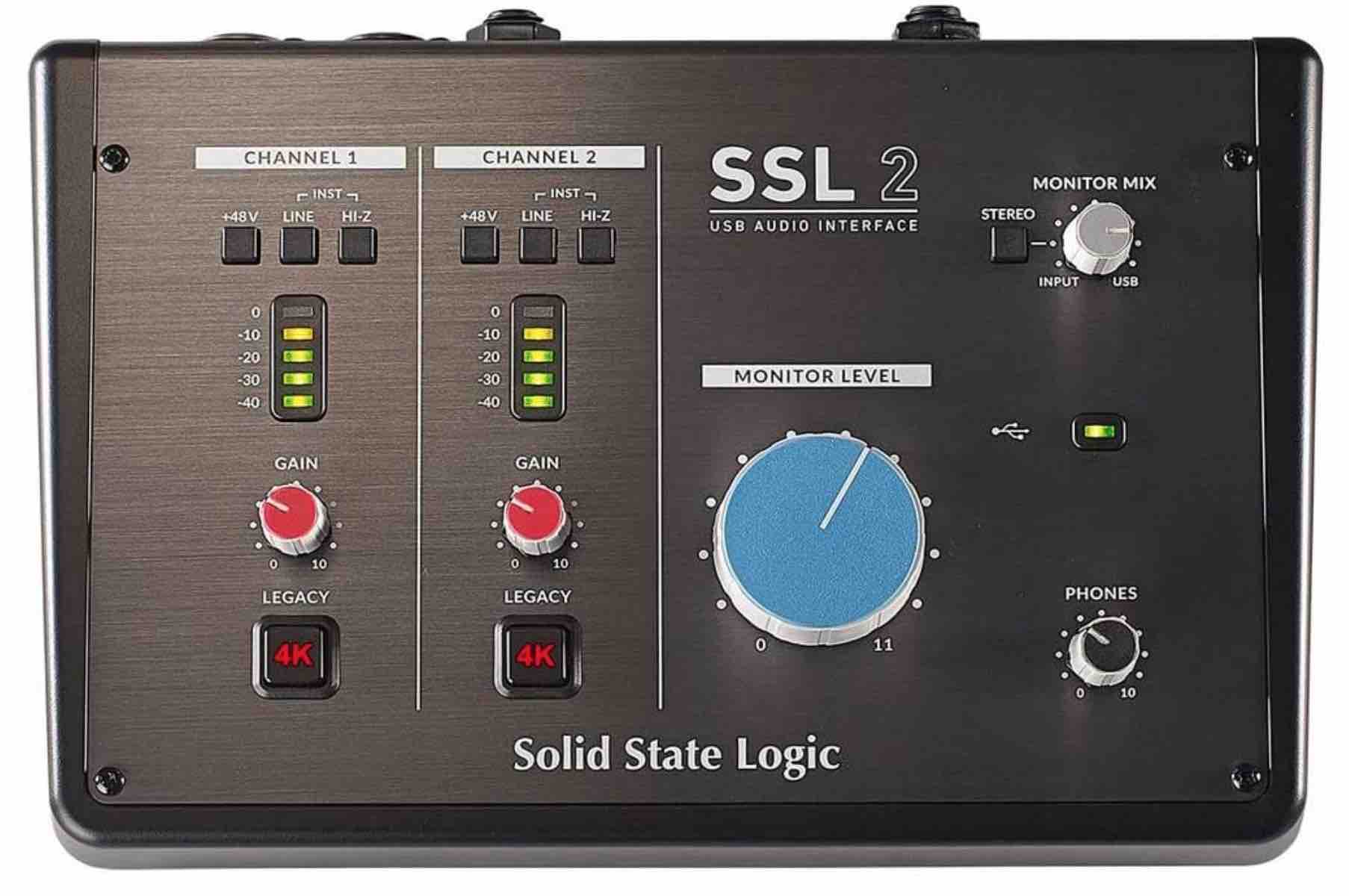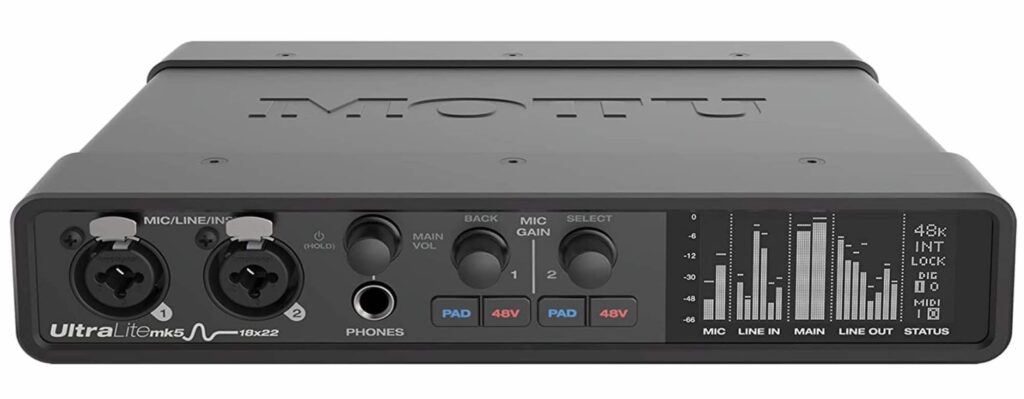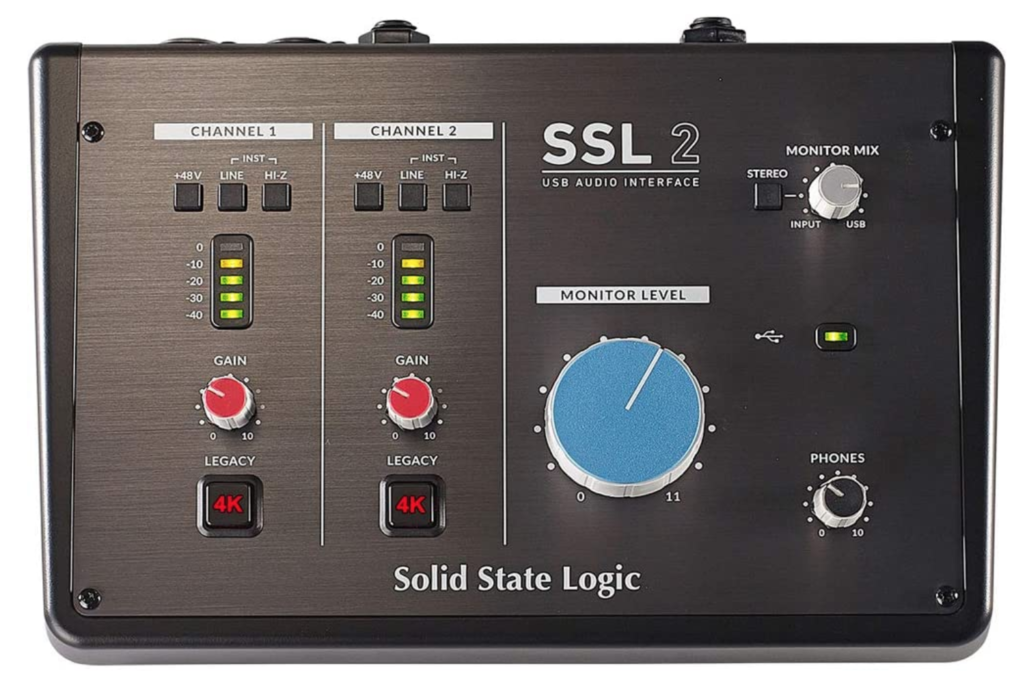Are you wondering what audio interface has the best preamps?
Well, you’re in the right place.
Your audio interface’s preamps play a major role in the quality of your audio. It can make or break your recordings.
But how can you tell the difference between a high and low-quality mic preamp?
Here’s how you tell – you’ll want one with a high amount of gain and a low noise floor.
High vs Low Quality Mic Preamps: What’s the Difference?
A high-gain, low-noise mic preamp can boost low-level signals from your mic without adding unwanted noise or distortion.
Conversely, one that’s subpar will produce audio that lacks clarity – especially when you’re recording with a dynamic mic.
Why?
A low gain preamp may not be able to provide your mic signal with enough clean amplification.
You’ll likely have to max out your gain or boost your mic signal during post-processing which can make preamp noise more audible.
In this post, we’ll review four audio interfaces with high-gain, low-noise mic preamps.
We’ll also provide tips on what to look for when shopping for a high-quality audio interface.
Overview

Motu UltraLite Mk5 (Best)
The Motu UltraLite Mk5 is a compact 18-input, 22-output interface with high-headroom, low-noise mic preamps that provide up to 75 dB of gain and a low equivalent input noise of around -129 dBu.
It also has built-in converters with a dynamic range of 118 dB, ADAT and SPDIF input and output, and DSP-based effects accessible through its CueMix 5 software.
The Mk5 is an excellent choice for podcasters, musicians, or engineers who need a lot of high-quality I/O on demand and want to capture cleaner audio, especially when using low-output dynamic mics like the Shure SM7B.

Universal Audio Apollo Twin X (Most Versatile)
The Universal Audio Apollo Twin X features two high-quality Unison-enabled mic preamps, 24-bit/192 kHz converters, and onboard UAD-powered plugins.
Its onboard DSP plugins allow for real-time effects processing without straining your computer's CPU or increasing latency.
It also has Unison-enabled preamps allowing you to record through classic preamp emulations from Neve, Helios, API, Manley, and more.
The Apollo Twin X is a versatile tool that can help you achieve the exact sound you're looking for.

Solid State Logic SSL2 (Budget Option)
The SSL 2 offers exceptional preamps with a 62 dB gain range and low EIN, along with features like high-resolution converters, two mic/line/instrument inputs with +48V phantom power, and Hi-Z inputs.
Its unique 4K Legacy Mode, which adds high-frequency boosts and harmonic distortion, sets it apart from other entry-level interfaces and helps recordings to sound brighter and more prominent.
While the lack of expandability may be a drawback, the SSL 2 is a great choice for those who need only 2 inputs at a time.

Focusrite Clarett+ 2Pre (Air Mode)
The Focusrite Clarett+ 2Pre audio interface offers two low-noise, high-headroom, Air-enabled mic preamps and 24-bit/192kHz converters for high-fidelity recording and playback.
Its Air Mode feature can give your vocal and acoustic recordings a sense of depth and presence, making your audio sound more polished.
Though more expensive than the Scarlett models, the Clarett+ 2Pre offers better audio quality, durability, and additional features like output routing.
How to Evaluate Mic Preamps
Maximum Gain Level
Look for the maximum gain level that the preamp can provide. This information is usually listed in the product specifications.
A higher gain level means that the preamp can amplify the microphone signal more, providing more headroom and allowing you to record quieter sources.
Equivalent Input Noise (EIN)
Top 4 Audio Interfaces with the Best Preamps
1. Motu UltraLite Mk5

Motu’s UltraLite Mk5 is known for its high-headroom, low-noise mic preamps – offering up to 75 dB of gain with a low equivalent input noise (EIN) of around -129 dBu.
Their high max gain capacity of 75 dB allows them to deliver clean audio with a wide range of microphones -especially low-output dynamic mics like the Shure SM7B.
In other words, you’ll have no problem capturing the subtle details in your recordings without your audio clipping or distorting.
Additionally, the Mk5’s built-in converters are very accurate, with a dynamic range of 118 dB.
A high dynamic range ensures this interface will capture a wide range of audio frequencies and levels with great detail, resulting in recordings that sound true to your original sound source.
I/O
The first thing you’ll notice is how compact the UltaLite Mk5 is for an 18-input, 22-output interface.
It has two mic/line/instrument inputs and 6 line inputs on the back.
You’ll also get 10 balanced outputs, a headphone jack, and a MIDI in and out. Plus it connects to your computer via USB-C, which is faster and more reliable than USB-B.
This model also comes with an ADAT and SPDIF input and output, allowing you to add 10 channels for larger recording sessions.
DSP Effects
You can access the UltraLite Mk5’s advanced features through the included CueMix 5 software.
Through this software, you can control the Mk5’s built-in digital signal processing (DSP) effects – including a reverb, EQ, compression, and gate plugin.
Since these effects are DSP-based, using them while recording won’t add a noticeable amount of latency – as opposed to recording through plugins in your DAW.
Should You Buy the Motu UltraLite Mk5?
If you’re a podcaster, musician, or engineer who needs a lot of high-quality I/O on demand but wants a compact interface, the Mk5 is an excellent choice.
You’ll get high-gain, low-noise mic preamps that provide plenty of headroom when setting your gain for low-output dynamic mics.
As a result, you can boost low-level mic signals without adding unwanted noise to your audio, allowing you to capture cleaner audio.
On the other hand, many entry-level interfaces – under $200 – tend to have a maximum gain level of under 55 dB.
Therefore, you may need to use a Cloudlifter or noise reduction software to capture clean audio with a budget interface.
However, if you don’t need more than 8 I/O at once, there are more affordable options with high-quality preamps.
For instance, the Solid State Logic SSL2 is a more affordable alternative that I’ll discuss later on this list.
You also won’t need preamps with 75 dB maximum gain if you’re only using condenser mics.
With a condenser mic, you can use a budget interface and still capture professional-sounding audio.
But if you want to produce top-quality audio with any mic and a lot of inputs, the Mk5 is one of the best options.
2. Universal Audio Apollo Twin

Credit: Universal Audio
Universal Audio’s Apollo Twin X could be number one on this list.
It features two top-quality Unison-enabled mic preamps, 24-bit/192 kHz converters, and onboard UAD-powered plugins.
A notable Apollo Twin feature is its Talkback button. This feature makes it easy to communicate with a performer in a separate recording room.
The Talkback button activates a microphone on the interface, allowing an engineer to speak to a recording artist directly through his headphones.
Additionally, you’ll get an advanced set of buttons that make adding a high-pass filter, +20 dB pad, and reversing polarity easy.
There’s also a button for linking your inputs for stereo recording, dimming and muting your outputs, activating +48 phantom powers, and more.
Any action you can think of when it comes to recording and monitoring your audio, the Twin has quick solution.
Digital Signal Processing (DSP)
The Apollo Twin’s onboard DSP plugins allow for real-time effects processing.
Since these effects are DSP-based, using them while recording won’t strain your computer’s CPU or increase latency.
The best part is the quality of the plugins you’ll have at your disposal.
These plugins are digital emulations of popular vintage analog outboard gear – such as the LA-2A and 1176 compressors and 610-B tube preamp.
This Apollo Twin feature gives you the ability to add sonic character to your recordings and mixes, without having to invest in expensive outboard gear or plugins.
Unison Preamps
What makes Twin X’s preamps unique is that they’re Unison-enabled.
What is Unison?
It’s UA’s preamp modeling technology.
This technology allows you to change your preamp’s characteristics to emulate classic preamps from Neve, Helios, API, Manley, and more.
Whether you’re aiming for a specific sound or want to experiment, through Unison you can adjust the input impedance of your preamps to influence the tone of your recordings.
Should You Buy the UA Apollo Twin X?
Overall, the Apollo Twin is an excellent choice for anyone looking for a high-quality audio interface with advanced preamp features.
It’s especially great for mac users since it connects via Thunderbolt.
If you’re just starting or are on a budget, the next option on this list will be a better choice.
But the Twin X’s onboard DSP plugins and advanced preamp features make it an incredibly versatile tool that can help you achieve the exact sound you’re looking for.
Plus, its solid build quality and intuitive interface design make it easy to use in any studio setup or on the go.
3. Solid State SSL 2

Credit: Solid State Logic
Solid State Logic’s SSL 2 offers some of the best preamps among entry-level interfaces.
Its preamps have a 62 dB gain range with an incredibly low EIN of -130 dBu – perfect for gain-hungry dynamic mics.
This model features high-resolution converters, two mic/line/instrument inputs with +48V phantom power, and Hi-Z inputs for recording guitars and basses.
It also has a pair of balanced outputs, a headphone output, a monitor mix knob for low-latency recording, and 4K Legacy mode.
4k Legacy Feature
The 4K Legacy is a feature that emulates the classic sound of SSL’s iconic 4000 series console, which was widely used in professional studios in the 1980s and 90s.
When the 4K Legacy Mode is engaged, the SSL 2 boosts high-frequencies and adds a subtle harmonic distortion to your audio signal – two characteristics that the 4000 series consoles are popular for.
These additions will make her audio sound brighter and more gritty, allowing your recordings to cut through your mix more effectively.
The 4K Legacy Mode is a unique feature that sets the SSL 2 apart from other entry-level audio interfaces. It can be useful if your audio tends to sound dull and you want to achieve a bigger and “punchier” sound.
Should You Buy the SSL 2?
Related Post: Solid State Logic SSL 2 Complete Review
4. Focusrite Clarett+ 2Pre

Credit: Focusrite
If you’re a fan of Focusrite’s Scarlett interfaces, consider its Clarett 2Pre model.
It offers two low-noise, high- headroom – Air-enabled – mic preamps, USB Type-C connection for low latency, and 24-bit/192kHz converters for high-fidelity recording and playback.
This model comes with two mic/line inputs, an ADAT input to – allowing you to add 8 inputs digitally, four line outputs, a headphone output, and a MIDI in and out.
The 2Pre also has great performing mic preamps.
They have a +57 dB gain range and and produce very little preamp noise with an EIN of -129 dBu.
You’ll even get a generous software bundle – including an autotune, reverb, EQ, compression, channel strip, and guitar amp plugin. Plus a piano and drum VST and a two-month Landr subscription for mastering your tracks.
This bundle may not be enough for you to produce a radio-ready single, but its a great stating point if you’re just getting started.
Air Mode
Air Mode is a unique preamp feature that enhances high-frequency detail in your recordings, emulating the classic sound of Focusrite’s original ISA mic preamps.
It’s perfect for adding a sense of depth and presence to vocal and acoustic instrument recordings, giving them a more professional and polished sound.
How does Air Mode work?
With Air Mode activated, the 2Pre lowers the input impedance of your mic input, slightly changing the tone of your audio.
This effect offers some of the benefits you get from using an external tube preamp without having to get an additional unit.
Should You Buy the Clarett+ 2Pre?
If you’re on a budget, we recommend the more affordable Focusrite Scarlett 8i6. But if you’re looking for maximize your audio quality and take advantage of Air Mode, the Clarett+ 2Pre is an excellent choice.
Clarett+ interfaces are more expensive than the Scarlett models. However, they produce better audio quality, have a more durable exterior, and come with extra features like output routing.
Audio Interface Preamp Specs Explained
Gain
Gain is the amount of amplification a preamp can provide to an audio signal.
Its typically represented as a range such as 0-60 dB.
0-60 dB means preamp provides 0 dB of gain at its lowest setting and 60 dB at its highest.
You’ll may also see gain range listed as a single number.
For instance, if an interface has a 60 dB gain range, its lowest gain setting could be -10 while its highest could be +50.
Sometimes interface manufactures will list the maximum gain level which indicates the total amount of gain an interface can supply and audio signal.
Equivalent Input Noise (EIN)
Naturally, all preamps introduce some noise when amplifying audio signals.
Ideally, we want this noise to be as low as possible.
Equivalent input noise give us an idea of how much preamp noise we can expect at high gain levels.
Paying attention to EIN is crucial if you’re using a dynamic mic.
Why?
Dynamic mics produce quieter signals than condenser mics.
As a result their signals need a higher gain boost to reach the proper level for recording.
Unfortunately, noise can become an issue if your interface has a low maximum gain level – typically below 50-55 dB – or a high EIN – greater than -127 dBu.
Is there a Major Difference Between Audio Interface Preamps?
The preamps in most audio interfaces will help you record professional-sounding audio from home.
However, preamps in higher-end interfaces tend to have superior circuit designs and higher-quality components.
Therefore, interfaces with top-quality preamps can maintain accuracy and clarity when boosting low-level signals.
For the most part, there’s not much of an audible difference between the preamps in budget and high-end units.
They mainly vary based on features like Unison-enabled preamps.
Mid-range to high-end interface also tend to have higher maximum gain levels and produce less preamp noise.
How Do Preamps Improve Sound Quality?
The quality of your preamps influences how your final product sounds.
High-quality preamps will amplify your low-level mic signals without adding a noticeable amount of preamp noise.
This allows your music to retain its original character and nuance while remaining loud and clear.
Clarity is crucial to recording professional-quality audio.
There’s nothing worse than having a bunch of white noise or static in the background of your recordings.
You can avoid this issue by making your interface’s preamps have a low noise floor and have enough gain for the type of mic your using.
Some preamps can also provide tonal shaping options to improve your sound further.
For instance, Air Mode in the Focusrite interfaces add high-end clarity and brightness to your recordings.
In addition to Air Mode, some preamps offer other tonal shaping options such as saturation, which adds a subtle harmonic distortion to your recordings.
There are also preamps that let you adjust their impedance, which can affect the tonal characteristics of your microphone or instrument.
These options give you greater flexibility and control over your sound, allowing you to tailor it to your preferences.
Transparent vs. Tube Preamps
Transparent preamps aim provide a clean, uncolored representation of your audio source.
The goal when using a transparent preamp is to amplify a sound source without altering its tonal characteristics.
This quality makes transparent preamps great for voiceover work, podcasting/streaming, and even recording music.
Conversely, a tube preamp will alter frequencies in your audio – adding warmth, depth, and harmonic distortion to your sound.
Most audio interfaces have transparent preamps, which technically won’t “improve” your sound quality.
To improve sound quality, consider using a quality tube preamp.
It’ll help you achieve a more organic and natural sounding audio.
Related Post: How to Connect a Preamp to an Audio Interface.
Tube Preamp Features
Conveniently, some interfaces come with tube preamp features.
As mentioned before, Air Mode in the Focusrite Clarett+ 2Pre is a tube preamp feature.
Enabling it will boost high frequencies in your audio, enhancing the overall clarity and presence of your recording.
Another example is Vintage Mode in the Universal Audio Volt 2.
It adds a bit of distortion to give your audio a more classic vintage feel.
How to Find the Best Audio Interface
Some factors to consider when looking for the best audio interface are high-resolution converters (24-bit/192kHz), low latency, a robust build quality, low noise preamps, and advanced features to aid your recording process.
Ultimately, the best way to tell if an interface is a good choice is to read reviews from trusted sources.
Additionally, reviews from other users can help you understand how well an interface performs.
Takeaway
These days, most audio interfaces have mic preamps that can help produce high-quality home studio recordings.
However, there are a few audio interfaces that stick out from the pack:
These interfaces have high-gain and low-noise preamps that work great with low output dynamic mics.
They also have advanced preamp features like Unison-enabled preamps with the Apollo Twin and 4K Legacy mode with the SSL 2.
You can use these preamp features to experiment with different tones and find your unique sound.
It’s basically like having an audio interface and a tube preamp in one device.
With these high-quality preamps and advanced features, these audio interfaces provide a versatile recording solution that can help you achieve professional-quality results.








